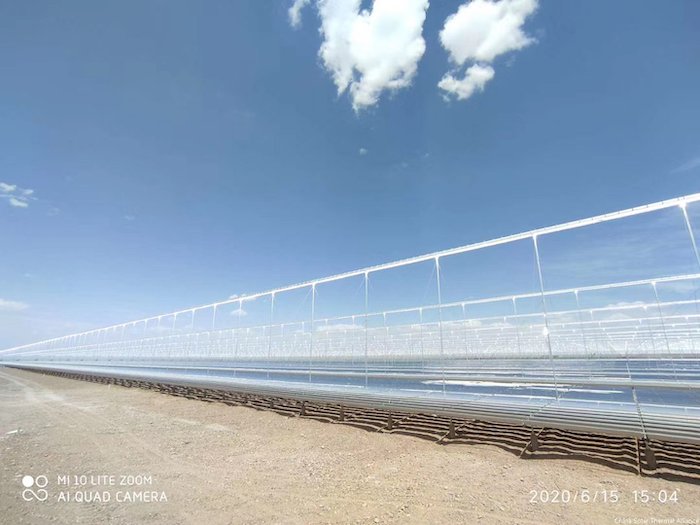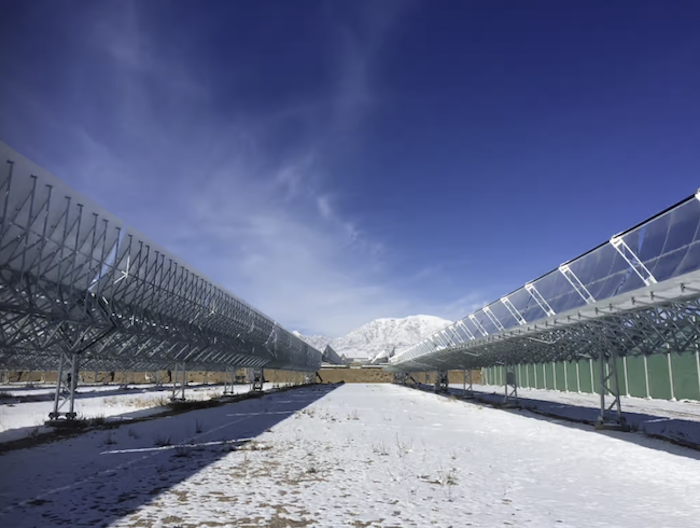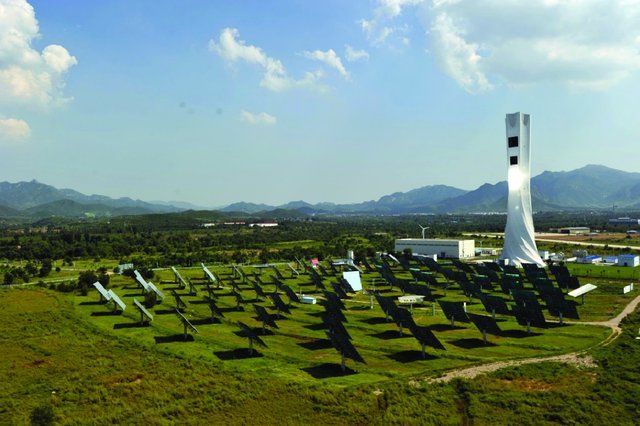Latest CSP in Construction: 2023 (three projects)
#1: Huidong New Energy 110 MW Beam-down Tower CSP

This new CSP technology (Beam-down tower) is the first project of this technology to be built within the “corporate-scale” series of 30 new CSP plants in 1 GW renewable energy parks. Project details: NREL. The initial Beam-down Tower project was built in the demonstration phase at 50 MW near the city of Suzhou (Jiuquan) in Gansu Province.
#2: Cosin Solar: Jinta Zhongguang 100 MW Tower CSP

This photo taken in November 2022 shows Cosin Solar’s Tower CSP (100 MW) project in construction in Gansu Province for the 100 MW Jinta Zhonguang CSP project. (details at NREL.) Their Phase I test and Phase II Pilots 10 MW and then 50 MW (as then-Supcon) were completed within the tough deadlines set. This one, Jinta Zhongguang, was originally one of three Three Gorges Renewables’ demonstration projects in 2016. Three Gorges failed to start in time, and Cosin took it over and was given more time to complete.
#3: CEIC/ Lanzhou Dacheng’s 100 MW Molten Salts Fresnel CSP

Like Cosin’s Tower and Huidong’s Beam-down, Lanzhou’s commercial scale Fresnel project was preceded by their test at 10 MW online in 2016, and then at 50 MW in 2020, a record for Fresnel: details at China Solar Thermal Alliance. China Energy Investment Corporation (CEIC) then helped Lanzhou Dacheng go big with the world’s first bold experiment in 100 MW Fresnel, with molten salts for its thermal energy storage – another global first. NREL: project details
Latest Online: 2020
CSNP/Royal Tech Urat – 100MW Trough CSP

Royal Tech added a new twist in their 100 MW Trough CSP in Urat, Mongolia. They innovated a novel (award-winning) silicon-based heat transfer fluid. Royal Tech integrated the solar field technology, and China Shipbuilding New Power (CSNP) was the EPC contractor (managing Engineering Procurement and Contracting).
Earliest Online: 2012
Badaling Dahan was built near Beijing as a university project, Dahan Solar Tower by the Institute of Electrical Engineering at the Chinese Academy of Sciences, a 1 MW Tower with 1 hour of storage.

Badaling Dahan – 1 MW Tower university demonstration
Country Data:

Policy Support
China required from the first demonstration phase that each CSP project must include thermal energy storage, marking the first recognition globally of the value of the low cost and longevity of thermal energy storage. As a power station storing solar energy thermally, CSP operates like a gas plant to supply grid services like rolling reserves. Compared to major economies like the US, China has relatively little natural gas to meet these needs.
Despite being the world’s leading battery producer, China set the requirement to include thermal storage starting with its initial demonstration program. This marked a departure from the earlier markets. Spain did not require storage. Of the five US projects the US built around 2013, California utilities did not predict a need for storage in the three PPAs it signed with developers.
Demonstration Program
Between 2013 and 2021,12 out of 20 original CSP Phase I demonstration projects (totaling 1.349 GW) came online in China. Granted in 2016, they had originally been incentivized through a delivery-based step-down tariff to be complete in two years. (CSP had taken about four years in the US at around this time.) Only three could meet the very tight deadline, TeraSolar (marketing Fresnel as industrial solar heat) in Hebei Province, at 15 MW, Cosin Solar’s 50 MW Tower and Shouhang’s 50 MW Tough CSP for CGN at Delingha. Another four were connected in 2019. Three of these were Tower, and all at 50 MW: LuNeng Haixi and Power China Qinghai Gonghe in Qinghai, and in Xinjiang, CEEC/Hami which pioneered another SolarPACES Innovation Award-winner, the Stellio heliostat. The fourth was Lanzhou’s 50 MW Fresnel at Daching.
To activate the undeveloped pilot projects, the National Energy Administration subsequently offered a slightly lower tariff if any could connect to the grid by 2021, to encourage confident startups like Cosin and Shouhang that emerged as major Tower CSP developers in China, to grab some of these lost opportunities. The most recent of these projects to get grid connected was Royal Tech’s Trough project in Mongolia.
Organized Growth
Chinese policy promised a predictable advance for its new CSP firms, through a test at 10 or 15 MW, demonstration at 50 MW, to full scale at 100 MW. Every project included thermal energy storage, typically 10 to 15 hours.
Cosin (as Supcon then) built their two Tower CSP demonstration projects at a solar park near the city of Delingha in Qinghai Province, first at 10 MW in 2013 Phase I and then at 50 MW in 2018 in Phase II. As of 2023, their 100 MW project is in construction, following this test, demonstration, full-scale trajectory, which has resulted in solving some technical problems with earlier Tower CSP. Founded in 2010, Cosin developed from the Gaosheng CSP Technology Research Institute.
Shouhang, a spin-off from Zhejiang University, built their first Tower CSP at a 10 MW scale in Dunhuang solar demonstration park. This had a record continuous 133 hours of power generation, and “has been operating with quite good performance for almost two years since the official start on December 26, 2016.” Then Shouhang served as the EPC for a different technology; Trough: for CGN at Delingha in Qinghai Province 50 MW, online in 2019. Shouhang’s own 100 MW Tower CSP came online in 2018 at the renewables park near the Gobi Desert city of Dunhuang in Gansu Province.
Lanzhou Dacheng first built a demonstration of Fresnel CSP at 10 MW in 2016, following it up three years later commercially at the same site near Dunhuang, at the desert’s edge of the Gobi Desert in Gansu Province, at 50 MW. This was the first Fresnel CSP in the world with molten salt for heat transfer and thermal energy storage (15 hours) and achieved temperatures close to that of Tower CSP at 535 C. Their 100 MW project (#3 above) was in construction as of 2023.
Despte being well-established globally, few Trough projects survived China’s Phase I. Even Fresnel and Beam-down did relatively better from a smaller start. Most CSP in China is Tower.
The new 1 GW Solar Park Rule:
In a new approach to advancing a high percent of renewable energy on the grid without falling back on gas backup, China set a rule that required 100 MW CSP project in each 1 GW renewable energy park. As of 2023, 30 CSP projects are in development as a result. China’s government then published a new requirement that grid operators must give “priority support to the grid connection and dispatching of the base projects equipped with solar thermal power.”
The first 100 MW CSP projects under the 1 GW Solar Park rule were under construction in 2023. These three were in three CSP technologies; Fresnel, Tower, and a new technology researched globally and tested at the Masdar Institute Solar Platform in the UAE: Beam-down.














































